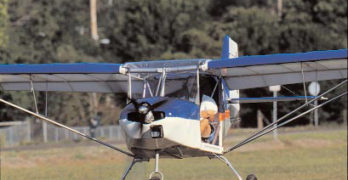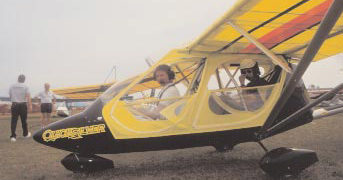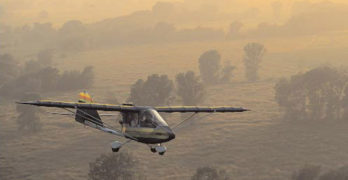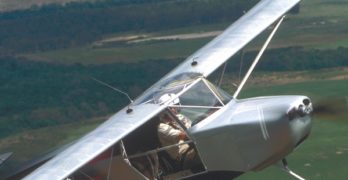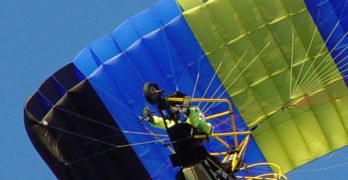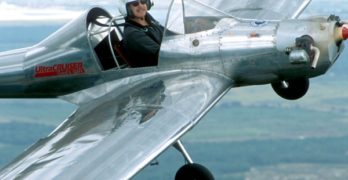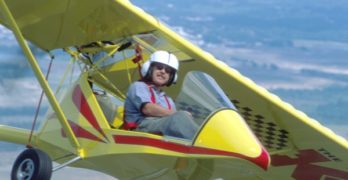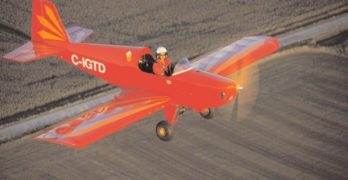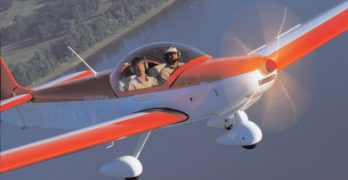The Leading Trainer in French Flight Schools
To many observers, the Sky Ranger looks like a RANS Coyote. Based on general appearances, it appears the French light plane borrowed heavily from the popular model sold by the Kansas light plane kit leader. But, Sky Ranger importer Richard Helm bristles a bit when he hears that statement and retorts, “People compare the Sky Ranger to the RANS Coyote. They say it’s a knockoff, but the French designer didn’t take anything from the Coyote. It’s built completely different,” although he admits, “It does look a lot like the Coyote.”
Give a Yankee welcome to the Sky
Ranger. The French-designed
ultralight is typical of a trend I
think we’ll be seeing with increasing
frequency—imported light planes from
Europe. Sky Ranger is built in the
Ukraine by Aeros, Ltd. I visited this
factory with Phil Lockwood of
Lockwood Aviation in the spring of
2001. Once built by Synairgy in France,
Sky Ranger production moved to this
former eastern-block country in 1997.
Search Results for : Flight Design
Not finding exactly what you expected? Try our advanced search option.
Select a manufacturer to go straight to all our content about that manufacturer.
Select an aircraft model to go straight to all our content about that model.
Honoring Mike Sacrey
Note to readers — This article first appeared in EAA Sport Pilot magazine. The layout is unusual because of magazine formatting, but all the text and photo information is as it originally appears… —DJ
AND LEARNING THE HISTORY OF FAR PART 103
Not long after takeoff, the airline captain’s deep voice transmitted the following: “Ah… Los Angeles Center, I see hang gliders not far off my wing. They aren’t in our airspace, but I’m surprised to see these guys up here.”
Thus began the impetus to create
Federal Aviation Regulation (FAR) Part
103. Of course, the rule had no name
at the outset, but one FAA official saw
the future.
Honoring the foresight of this
man, EAA recently inducted W.
Michael “Mike” Sacrey into the EAA
Ultralight Hall of Fame during
ceremonies on November 2, 2001, at
EAA headquarters in Oshkosh,
Wisconsin.
Mike holds an airline transport pilot
(ATP) rating with numerous sign-offs
for a variety of jets and multiengine
seaplanes.
Hawks and their History
A look at CGS Aviation and its Roots
The Hawk and Chuck. Chuck
and the CGS Hawk. They are
absolutely intertwined. While
Chuck has a wife, Pixie (aka Nancy),
and family—four sons (Chuck Jr.,
David, Ted, and Don)—he has
another family in his aircraft.
Going Way Back
Our story this month takes us back
in time. EAA recently celebrated the
induction of Michael Sacrey into the
Ultralight Hall of Fame. He was
present near the beginning of the
movement. But even before
ultralights were officially recognized
as a segment of aviation, Chuck was
doing essentially what he is doing
today—selling flying machines.
In the early days, Chuck built
hang gliders, with names like the
Swooper, Spitfire, and Falcon (models
I through VII). While hang gliding
was most popular on the West Coast
and many major hang glider
manufacturers were located there,
hang gliding was also popular along
the dunes of the Great Lakes, and
Chuck’s operation was one of the
biggest in the eastern part of the
country.
An Escapade Just for You
Engineering design is usually an evolutionary process. While occasionally a breakthrough idea comes to market, most development in aviation is a result of small steps. The Escapade is a good example.
Once Flying K Enterprises (now Sky Raider LLC) offered their Sky Raider. The single-seater had much in common with the immensely popular SkyStar Aircraft Kitfox. In fact, when SkyStar offered their Kitfox Lite single-seater, Flying K built the welded fuselage for them.
Then came the Sky Raider II with a tight back seat that could be used for an occasional ride though not instruction as no controls were installed in the rear. The new Summit offered by Just Aircraft late last year was a variation on the Sky Raider II theme.
Company leadership changes as do their designs and the path from Flying K to Just Aircraft is convoluted; other business names are involved. By example, Rocky Mountain Wings, run by former Flying K partner Stace Schrader, offers their very similar Ridge Runner.
Gemini Powered Parachutes Come From Experience
According to the new Ultralight Flying! “Ultralight and Microlight Buyer’s Guide,” 24 companies are building powered parachutes in 2003. That figure doesn’t include recently announced foreign competitors and doesn’t count all that may follow. How does a new company stand out in such a crowd?
Gemini Industries boss Randy Snead is a well-known personality among powered parachute enthusiasts. He was the main technical person with Buckeye Industries, working with FAA personnel for months in pursuit of Primary Category certification. In blazing that new trail, Snead earned a reputation as being serious and knowledgeable.
His business enterprise is new to the scene, but given Snead’s long experience in this segment of light aviation, Gemini Industries should prosper. I see the company surviving any industry shakeout as the Indiana company keeps its overhead low and offers reliable products at low prices with reasonable delivery times. Gemini Industries isn’t flamboyant like some powered parachute producers and that’s exactly why Gemini’s formula should work.
Cosmos Phase III
One of the first trikes I flew was a Cosmos, way back in 1984. It was a trendsetter then and was one stoutly built trike capable of real functions. The reason I flew and owned a Cosmos in those early ultralight days was due to its capability as a tug for hang gliders. I’ve been involved with hang gliding for many more years than powered ultralights so when the two dovetailed in the Cosmos Tug, I was pleased to the point of purchase. Maybe you’ll also be so moved.
Today’s Cosmos Phase III trike is vastly better than that ’84 model. But it retains the brand familiarity (albeit with different ownership) and functionality while increasing the state of the art to a highly refined point.
In the 18 years since that first Cosmos experience, I’ve flown all Cosmos entries except the Echo. This new Phase III appeared in many ways to be the French company’s finest work.
Long-Lasting UltraCruiser Fun Plane
A Gift of Design
The UltraCruiser was born under rather unusual circumstances. Its designer, Morry Hummel, was not a young engineer with a passion for flying ultralights. On the contrary, Hummel is one of aviation’s pioneers with many years of experience. His story identifies how he found the time to create the UltraCruiser and, in particular, why the ultralight is fully named UltraCruiser, God’s Gift.
Hummel wrote, “I crashed my miniMAX on July 19, 1995. I lost my right leg below the knee, my left leg was badly broken, and my face crushed. My teeth were wired shut for 10 weeks and I was fed through a tube in my stomach.
“While I was in the hospital for 5 months, I had time to think. God had spared my life for a reason. The UltraCruiser is named God’s Gift because I am only 85 years young and flying again.”
I found it an inspiring story.
New Kolb’s FireStar, Flyer and Sport 600
Once Kolb’s FireStar was a new design; a second-generation evolution for the company then headquartered in Pennsylvania. The first Kolb single-seaters were later joined by the TwinStar, the company’s original 2-seater, all of which preceded the FireStar series.
Under the direction of Homer Kolb and Dennis Souder, the original Kolb Company followed their success with the FireStar by creating the Mark III 2-seater, FireFly single-seater, and SlingShot tandem 2-seater. They also worked on but never released the Laser.
In 1999 Bruce Chesnut and Brian Blackwood purchased Kolb Aircraft from Dennis Souder who, along with other partners had owned the enterprise since 1994. Chesnut and Blackwood renamed the company The New Kolb Aircraft Company and moved it to new facilities at the Chesnut Knolls Aviation Foundation Airpark in London, Kentucky.
The Kentucky-based company has focused on model revisions such as the Kolbra and King Kolbra, and the Mark III Xtra. Most recently, The New Kolb Aircraft Company has entered the powered parachute market with their Flyer, and to the proposed Light-Sport Aircraft segment with the Pelican Sport 600.
Murphy Aircraft Returns to Its Roots
After ever-bigger Rebels, the JDM – 8 is a genuine ultralight
Darryl Murphy’s commitment to
small plane design is evident
by the fact that during the
years when Murphy Aircraft Mfg. exhibited
in two locations at various
fly-ins, Darryl frequently was seen
working his company’s booth in the
ultralight area. Other Murphy Aircraft
staff members would be working the
Rebel/Super Rebel booth. At the Northwest
EAA Fly-In in Arlington,
Washington, this past summer, that
pattern re-emerged; the boss stayed
with the JDM-8 in the ultralight exhibit
area. In my conversations with
him, he seemed pleased to be presenting
a genuine ultralight again.
Those who know the history of
Murphy Aircraft before the first Rebel
arrived won’t be surprised to see the
company marketing an ultralight.
This Canadian manufacturer was an
ultralight company that expanded
into homebuilts and has achieved success
through their Rebel series. The
new single-seat JDM-8—especially
when contrasted with the huge, radialengine-
powered Moose—shows this
company has not forgotten its roots in
ultralight aircraft.
Zenith’s Sport Pilot Entry
Chris Heintz’s Zodiac CH 601 XL design fits perfectly
Chris Heintz is a respected designer of light aircraft, and the
Zenith Aircraft Co., led by his sons Sebastian and Nick, is a successful
kit manufacturer with worldwide impact. The company’s
Zodiac line is a well-accepted series of aircraft with good performance
and handling. So, why did I think the Zodiacs were boring?
The answer’s simple—because they
look like little Piper Cherokees.
Now, both New Piper Aircraft and
Zenith make fine aircraft with
better-than-expected performance for
their class. But they’re just…well…conventional,
expected, familiar. They seem
to be a factory sedan at a sports car show.
A flight in the Zodiac XL with Nick
changed my view. I now have a better
understanding of the solid reputation of
this Canadian designer, this company,
and these aircraft. I greatly enjoyed the
hour Nick and I spent buzzing about the
central Florida landscape.
The Zodiac Line
Developed by Chris Heintz, the Zodiac
line today includes four different models.
- « Previous Page
- 1
- …
- 138
- 139
- 140
- 141
- 142
- …
- 148
- Next Page »


